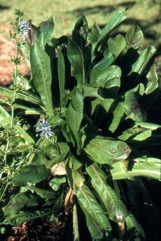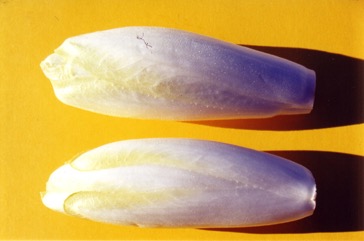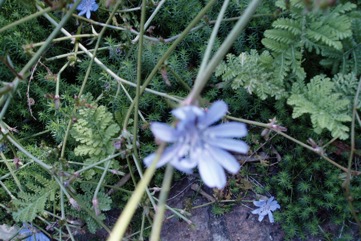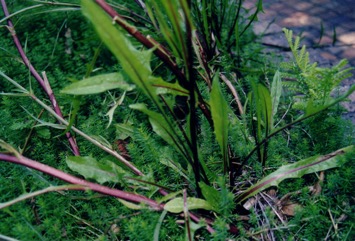Chickory, Chicory

A Mediterranean plant. It grows in the highlands in the tropics. In Java it grows above 1,000 m altitude. It can grow in arid places. It suits hardiness zones 9-11. Tasmania Herbarium. In Yunnan.
Also known as:
Achicoria, Achicoria silvestre, Aci ot, Adghorro, Asparagus chicory, Belgian endive, Bouagad, Cakankam Camarroja, Catalonia, C'corji, Cekanka obecna, Chicoree, Chi-ko-ri, Cicoria selvatica, Cicoria, Cicuriedde, Cikorija, Cizdankus, Cykoria the traveller, Escarola borda, Hindlauf, Hindiba, Hinidibag, Indivia, Jangli hand, Kasani, Kashini, Kasini, Kasni, Katang, Keklik otu, Khap'arai, Mavihindiba, Navadni potrošnik, Pikroradiko, Posh hand, Puntarelle, Radic, Radicchio di campo, Radicchio, Radiki, Sakizotu, Sickouria, Sigur, Succory, Talisk, Tuhovnik, Vad cikoria, Vodopija, Witloof, Xicoira, Yabani hindiba, Zichorie, Zucenica, Zutanca, Zutanica
Synonyms
- Cichorium intybus var. foliosum Hegi
- Cichorium intybus var. sativum (Bisch.) Janch.
Edible Portion
- Leaves, Stems, Roots, Herb, Spice, Vegetable
Where does Chickory grow?
Found in: Afghanistan, Africa, Albania, Algeria, Argentina, Armenia, Asia, Australia, Austria, Azores, Balkans, Belarus, Belgium, Bermuda, Bolivia, Bosnia, Brazil, Britain, Bulgaria, Canada, Canary Islands, Caucasus, Central Asia, Chile, China, Crete, Croatia, Cuba, Cyprus, Czech Republic, Denmark, East Africa, Easter Island, Egypt, Estonia, Eswatini, Ethiopia, Europe, Falklands, Finland, France, Georgia, Germany, Ghana, Greece, Guatemala, Hawaii, Himalayas, Holland, Hungary, India, Indochina, Indonesia, Iran, Iraq, Ireland, Italy, Jordan, Kazakhstan, Kyrgyzstan, Latvia, Lebanon, Luxembourg, Macedonia, Malaysia, Mediterranean, Mexico, Moldova, Mongolia, Montenegro, Morocco, Myanmar, Netherlands, New Zealand, North Africa, North America, Norway, Pacific, Pakistan, Papua New Guinea, PNG, Philippines, Poland, Portugal, Romania, Saudi Arabia, Scandinavia, SE Asia, Serbia, Sicily, Slovakia, Slovenia, Somalia, South Africa, Southern Africa, South America, Spain, Swaziland, Switzerland, Syria, Taiwan, Tasmania, Thailand, Tunisia, Turkey, Ukraine, Uruguay, United States, West Africa, Yugoslavia, Zimbabwe
Notes: There are about 9 Cichorium species. Tubers are rich in inulin and sugar.
Status: It is a commercially cultivated vegetable. Mainly in the gardens of expatriates within Papua New Guinea. It is also foraged from the wild and supplied to restaurants.
Growing Chickory, Chicory
Cultivation: Plants are grown from seed. Seed are sown 15 mm apart, in rows 20 cm apart. Seedlings do not transplant easily. Young tender shoots are formed by stripping roots of their leaves then covering with soil. Roots the size of a parsnip are harvested. These are then planted upside down in trenches in sand and after a few weeks more soil is added to exclude all light. The chicons are ready to use in 9-12 weeks.
Edible Uses: The leaves and plant are eaten raw or cooked. They are bitter. Young leaves are less bitter. They are used in soups. The roots of some kinds are dried, roasted and powdered then added to coffee. The flowers can be used in salads. The large blanched heads are steamed or served raw. A chewing gum is produced from the sap.
Production: Roasted chicory is made by digging up the taproot washing them cutting and drying the root then roasting.
Nutrition Info
per 100g edible portion| Edible Part | Energy (kcal) | Protein (g) | Iron (mg) | Vitamin A (ug) | Vitamin c (mg) | Zinc (mg) | % Water |
|---|---|---|---|---|---|---|---|
| Stem/young witloof Leaves raw | 17 | 0.8 | 0.3 | 3 | 4 | 0.2 | 96.2 |
| Leaves | 23 | 1.7 | 0.9 | 4 | 24 | 0.4 | 92 |
| Roots - raw | 73 | 1.4 | 0.8 | 1 | 5 | 0.3 | 80 |
Chickory, Chicory Photos




References
Abbasi, A. M., Khan, M & Zafar, M., 2013, Ethno-medicinal assessment of some selected wild edible fruits and vegetables of Lesser-Himalayas, Pakistan. Pak. J. Bot. 45 (SI):215-222
Abbet, C., et al, 2014, Ethnobotanical survey on wild alpine food plants in Lower and Central Valais (Switzerland). Journal of Ethnopharmacology 151 (2014) 624–634
Ambasta, S.P. (Ed.), 2000, The Useful Plants of India. CSIR India. p 124
Arora, R. K., 2014, Diversity in Underutilized Plant Species - An Asia-Pacific Perspective. Bioversity International. p 101
Balut, G., 2016, Medicinal and wild food plants of Marmara Island (Balikesir - Turkey). Acta Societatis Botanicorum Poloniae 85 (2): 3501
Batal, M. & Hunter, E., 2007, Traditional Lebanese recipes based on wild plants: An answer to diet simplification? Food and Nutrition Bulletin, vol. 28, no. 2 (supplement) © 2007, The United Nations University.
Ben Ismail, H., 2013, Edible Wild Vegetables Used in North West of Tunisia. PARIPEX - Indian Journal of Reearch 2(9) :219-221
Bianchini, F., Corbetta, F., and Pistoia, M., 1975, Fruits of the Earth. Cassell. p 42
Biscotti, N. & Pieroni, A., 2015, The hidden Mediterranean diet: wild vegetables traditionally gathered and consumed in the Gargano area, Apulia, SE Italy. Acta Societatis Botanicorum Poloniae 84 (3): 327-338
Biscotti, N. et al, 2018, The traditional food use of wild vegetables in Apulia (Italy) in the light of Italian ethnobotanical literature. Italian Botanist 5:1-24
Blamey, M and Grey-Wilson, C., 2005, Wild flowers of the Mediterranean. A & C Black London. p 459
Blanco-Salas, J., et al, 2019, Wild Plants Potentially Used in Human Food in the Protected Area “Sierra Grande de Hornachos” of Extremadura (Spain). Sustainability 2019, 11, 456
Bodkin, F., 1991, Encyclopedia Botanica. Cornstalk publishing, p 257
Bonet, M. A. & Valles, J., 2002, Use of non-crop food vascular plants in Montseny biosphere reserve (Catalonia, Iberian Peninsula). International Journal of Food Sciences and Nutrition (2002) 53, 225–248
Bremness, L., 1994, Herbs. Collins Eyewitness Handbooks. Harper Collins. p 241
Brickell, C. (Ed.), 1999, The Royal Horticultural Society A-Z Encyclopedia of Garden Plants. Convent Garden Books. p 268
Brouk, B., 1975, Plants Consumed by Man. Academic Press, London. p 102, 347
Brown, D., 2002, The Royal Horticultural Society encyclopedia of Herbs and their uses. DK Books. p 168
Burkill, I.H., 1966, A Dictionary of the Economic Products of the Malay Peninsula. Ministry of Agriculture and Cooperatives, Kuala Lumpur, Malaysia. Vol 1 (A-H) p 544
Burnie, G & Fenton-Smith, J., 1999, A Grower's Guide to Herbs. Murdoch Books. p 23
Cakir, E. A., 2017, Traditional knowledge of wild edible plants of Iğdır Province (East Anatolia, Turkey). Acta Soc Bot Pol. 2017;86(4):3568.
Cerne, M., 1992, Wild Plants from Slovenia used as Vegetables. Acta Horticulturae 318
Cheifetz, A., (ed), 1999, 500 popular vegetables, herbs, fruits and nuts for Australian Gardeners. Random House p
Ciocarlan, N. & Ghendov, V., 2015, Ethnobotanical and Ecological Studies of Wild Edible Plants from Bugeac Steppe, Republic of Moldova. Journal of EcoAgriTourism. Cailta terra Vol. 11(2):
Cordero, S. E., Abello, L. A., & Galvez, F. L., 2017, Plantas silvestres comestibles y medicinales de Chile y otras partes del mundo. CORMA p 160
Crawford, M., 2012, How to grow Perennial Vegetables. Green Books. p 86
Cribb, A.B. & J.W., 1976, Wild Food in Australia, Fontana. p 118, 178
Cundall, P., (ed.), 2004, Gardening Australia: flora: the gardener's bible. ABC Books. p 378
Curtis, W.M., 1963, The Students Flora of Tasmania Vol 2 p 380
Dalar, A., et al, 2016, Health attributes of ethnic vegetables consumed in the Eastern Anatolia region of Turkey: Antioxidant and enzyme-inhibitory properties. Journal of Ethnic Foods. 3 (2016) 142-149
Dashorst, G.R.M., and Jessop, J.P., 1998, Plants of the Adelaide Plains & Hills. Botanic Gardens of Adelaide and State Herbarium. p 154
Della, A., et al, 2006, An ethnobotanical survey of wild edible plants of Paphos and Larnaca countryside of Cyprus. J. Ethnobiol. Ethnomed. 2:34
Denes, A., et al, 2012, Wild plants used for food by Hungarian ethnic groups living in the Carpathian Basin. Acta Societatis Botanicorum Poloniae 81 (4): 381-396
de Polle, E., Plantas Silvestres Comestible de Guatemala. 1(1) Universidad de San Carlos de Guatemala.
Diaz-Betancourt, M., et al, 1999, Weeds as a future source for human consumption. Rev. Biol. Trop. 47(3):329-338
Dogan, Y., et al, 2004, The Use of Wild Edible Plants in Western and Central Anatolia (Turkey). Economic Botany 58(4) pp. 684-690
Dogan, Y., 2012, Traditionally used wild edible greens in the Aegean Region of Turkey. Acta Societatis Botanicorum Poloniae 81(4): 329-342
Dogan, A. & Tuzlaci, E., 2015, Wild Edible Plants of Pertek (Tunceli-Turkey). Marmara Pharmaceutical Journal 19: 126-135
Dolina, K. & Luczaj, L., 2014, Wild food plants used on the Dubrovnik coast (south-eastern Croatia) Acta Soc Bot Pol 83(3):175–181
Dretakis, M. et al, 2012, Flora and Fauna Biodiversity in an ancient olive grove in Crete (Greece) in Calabrese G. (Ed.) Study on Biodiversity in Century-Old Olive Groves. CIHEAM - Mediterranean Agronomic Institute of Bari. p 94
Duke, J.A., 1992, Handbook of Edible Weeds. CRC Press. p 72
Elias, T.S. & Dykeman P.A., 1990, Edible Wild Plants. A North American Field guide. Sterling, New York p 115
Ertug, F., 2000, An Ethnobotanical Study in Central Anatolia (Turkey). Economic Botany Vol. 54. No. 2. pp. 155-182
Ertug, F, Yenen Bitkiler. Resimli Türkiye Florası -I- Flora of Turkey - Ethnobotany supplement
Esperanca, M. J., 1988. Surviving in the wild. A glance at the wild plants and their uses. Vol. 1. p 219
Facciola, S., 1998, Cornucopia 2: a Source Book of Edible Plants. Kampong Publications, p 36
French, B.R., 1986, Food Plants of Papua New Guinea, A Compendium. Asia Pacific Science Foundation p 154
Geng, Y., et al, 2016, Traditional knowledge and its transmission of wild edibles used by the Naxi in Baidi Village, northwest Yunnan province. Journal of Ethnobiology and Ethnomedicine. 12:10
Gouldstone, S., 1983, Growing your own Food-bearing Plants in Australia. Macmillan p 166
Grubben, G. J. H. and Denton, O. A. (eds), 2004, Plant Resources of Tropical Africa 2. Vegetables. PROTA, Wageningen, Netherlands. p 560
Hadfield, J., 2001, The A-Z of Vegetable Gardening in South Africa. Struik p 104
Hadjichambis, A. C., et al, 2007, Wild and semi-domesticated food plant consumption in seven circum-Mediterranean areas. International Journal of Food Sciences and Nutrition. 2007, 1-32.
Hancer, C. K., et al, 2020, Traditional Knowledge of Wild Edible Plants of Biga (Çanakkale), Turkey. Acta Societatis Botanicorum Poloniae / 2020 / Volume 89 / Issue 1 / Article 8914
Hedrick, U.P., 1919, (Ed.), Sturtevant's edible plants of the world. p 191
Hemphill, I, 2002, Spice Notes. Macmillan. p 115
Heywood, V.H., Brummitt, R.K., Culham, A., and Seberg, O. 2007, Flowering Plant Families of the World. Royal Botanical Gardens, Kew. p 47
Hibbert, M., 2002, The Aussie Plant Finder 2002, Florilegium. p 67
http://nordicfood lab/org/blog/2102/9/wild-edible-plants-an-overview
Hussey, B.M.J., Keighery, G.J., Cousens, R.D., Dodd, J., Lloyd, S.G., 1997, Western Weeds. A guide to the weeds of Western Australia. Plant Protection Society of Western Australia. p 94
Hu, Shiu-ying, 2005, Food Plants of China. The Chinese University Press. p 725
Irving, M., 2009, The Forager Handbook, A Guide to the Edible Plants of Britain. Ebury Press p 145
Jackes, D. A., Edible Forest Gardens
Jardin, C., 1970, List of Foods Used In Africa, FAO Nutrition Information Document Series No 2.p 67
Jeambey, Z., et al, 2009, Perceived health and medicinal properties of six species of wild edible plants in north-east Lebanon. Public Health Nutrition: 12(10), 1902-1911
Kalle, R. & Soukand, R., 2012, Historical ethnobotanical review of wild edible plants of Estonia (1770s-1960s) Acta Societatis Botanicorum Poloniae 81(4):271-281
Kays, S. J., and Dias, J. C. S., 1995, Common Names of Commercially Cultivated Vegetables of the World in 15 languages. Economic Botany, Vol. 49, No. 2, pp. 115-152
Kiple, K.F. & Ornelas, K.C., (eds), 2000, The Cambridge World History of Food. CUP p 1753, 1840
Kizilarslan, C. & Ozhatay, N., 2012, An ethnobotanical study of the useful and edible plants of İzmit. Marmara Pharmaceutical Journal 16: 134-140, 2012.
Kybal, J., 1980, Herbs and Spices, A Hamlyn Colour Guide, Hamlyn Sydney p 72
Ladio, A., Lozada, M. & M. Weigandt, 2007, Comparison of traditional wild plant knowledge between aboriginal communities inhabiting arid and forest environments in Patagonia, Argentina. Journal of Arid Environments 69 (2007) 695–715
Lamp, C & Collet F., 1989, Field Guide to Weeds in Australia. Inkata Press. p 76
Lazarides, M. & Hince, B., 1993, Handbook of Economic Plants of Australia, CSIRO. p 60
Licata, M., et al, 2016, A survey of wild plant species for food use in Sicily (Italy) – results of a 3-year study in four Regional Parks. Journal of Ethnobiology and Ethnomedicine 12:12
Lim, T. K., 2015, Edible Medicinal and Non Medicinal Plants. Volume 9, Modified Stems, Roots, Bulbs. Springer p 24
Long, C., 2005, Swaziland's Flora - siSwati names and Uses http://www.sntc.org.sz/flora/
Low, T., 1991, Wild Herbs of Australia and New Zealand. Angus & Robertson. p 30
Low, T., 1992, Bush Tucker. Australia’s Wild Food Harvest. Angus & Robertson. p 26
Luczaj, L., 2012, Ethnobotanical review of wild edible plants of Slovakia. Acta Societatis Botanicorum Poloniae 81(4):245-255
Luczaj, L. et al, 2012, Wild food plant use in 21st century Europe: the disappearance of old traditions and the search for new cuisines involving wild edibles. Acta Soc Bot Pol 81(4):359–370
Luczaj et al, 2013, Wild vegetable mixes sold in the markets of Dalmatia (southern Croatia). Journal of Ethnobiology and Ethnomedicine. 8:2
Luczaj, L. et al, 2013, Wild food plants used in the villages of the Lake Vrana Nature Park (northern Dalmatia, Croatia). Acta Societatis Botanicorum Poloniae, 82(4): 275-281
Lukasz, L., 2016, Wild Edible Plants Traditionally Used in Poland.
Mabey, R., 1973, Food for Free. A Guide to the edible wild plants of Britain, Collins. p 71, 84
MacKinnon, A., et al, 2009, Edible & Medicinal Plants of Canada. Lone Pine. p 330
Martin, F.W. & Ruberte, R.M., 1979, Edible Leaves of the Tropics. Antillian College Press, Mayaguez, Puerto Rico. p 117, 184
Miguel, E., et al, 1989, A checklist of the cultivated plants of Cuba. Kulturpflanze 37. 1989, 211-357
Mir, M. Y., 2014, Documentation and ethnobotanical survey of wild edible plants used by the tribals of Kupwara, J & K, India. International Journal of Herbal Medicine. 2(4): 11-18
Morley, B. & Everard, B., 1970, Wild Flowers of the World. Ebury press. Plate 22
Nassif, F., & Tanji, A., 2013, Gathered food plants in Morocco: The long forgotten species in Ethnobotanical Research. Life Science Leaflets 3:17-54
Nebel, S., Pieroni, A. & Heinrich, M., 2006, Ta cho`rta: Wild edible greens used in the Graecanic area in Calabria, Southern Italy. Appetite 47 (2006) 333–342
Ochse, J.J. et al, 1931, Vegetables of the Dutch East Indies. Asher reprint. p 125
Ozbucak, T. B., et al, 2007, Nutrition Content of Some Wild Edible Plants in the Central Black Sea Region of Turkey. International Journal of Natural and Engineering Sciences 1:11-13
Paczkowska, G. & Chapman, A.R., 2000, The Western Australian Flora. A Descriptive Catalogue. Western Australian Herbarium. p 159
PARMENTIER (As Cichorium sylvestre)
Pieroni, A., 1999, Gathered wild food plants in the Upper Valley of the Serchio River (Garfagnana), Central Italy. Economic Botany 53(3) pp 327-341
Pieroni, A., 2001, Evaluation of the Cultural Significance of Wild Food Botanicals traditionally Consumed in Northwestern Tuscany, Italy, Journal of Ethnobiology 21(1):89-104
Pieroni, A., et al, 2005, Food for two seasons: Culinary uses of non-cultivated local vegetables and mushrooms in a south Italian village. International Journal of Food Sciences and Nutrition, 56(4): 245-272
Pieroni, A., et al, 2012, "We are Italians!": The Hybrid Ethnobotany of a Venetian Diaspora in Eastern Romania. Human Ecology 40:435-451
Pieroni, A. & Soukand, R., 2018, Forest as Stronghold of Local Ecological Practice: Currently Used Wild Food Plants in Polesia, Northern Ukraine. Economic Botany, XX(X) pp. 1-21
Plants for a Future database, The Field, Penpol, Lostwithiel, Cornwall, PL22 0NG, UK. http://www.scs.leeds.ac.uk/pfaf/
Purseglove, J.W., 1968, Tropical Crops Dicotyledons, Longmans. p 53
Redzic, S. J., 2006, Wild Edible Plants and their Traditional Use in the Human Nutrition in Bosnia-Herzegovina. Ecology of Food and Nutrition, 45:189-232
Redzic, S., 2010, Use of Wild and Semi-Wild Edible Plants in Nutrition and Survival of People in 1430 Days of Siege of Sarajevo during the War in Bosnia and Herzegovina (1992–1995). Coll. Antropol 34 (2010) 2:551-570
Royal Botanic Gardens, Kew (1999). Survey of Economic Plants for Arid and Semi-Arid Lands (SEPASAL) database. Published on the Internet; http://www.rbgkew.org.uk/ceb/sepasal/internet [Accessed 11th April 2011]
Ruiters-Welcome, A. K., 2019, Food plants of southern Africa. Ph.D. thesis. Univ. of Johannesburg p 33
Sanchez-Mata, M. C., et al, 2010, Wild vegetables of the Mediterranean area as valuable sources of bioactive compounds. Genet. Resourc. Crop Evol. 59:431-443
Sansanelli, S., et al, 2014, Wild food plants traditionall consumed in the area of Bologna (Emilia Romagna region, Italy). Journal of Ethnobiology and Ethnomedicine 10:69
Schneider, E., 2001, Vegetables from Amaranth to Zucchini: The essential reference. HarperCollins. p 85, 246, 517
Senkardes, I & Tuzlaci, E., 2016, Wild Edible Plants of Southern Part of Nevsehir inTurkey. Marmara Pharmaceutical Journal 20:34-43
Sher, H. et al, 2011, Ethnobotanical and Economic Observations of Some Plant Resources from the Northern Parts of Pakistan. Ethnobotany research & Applications 9:027-041
Simkova, K. et al, 2014, Ethnobotanical review of wild edible plants used in the Czech Republic. Journal of Applied Botany and Food Quality 88, 49-67
Singh, H.B., Arora R.K.,1978, Wild edible Plants of India. Indian Council of Agricultural Research, New Delhi. p 21
Skinner, G. & Brown, 1981, C., Simply Living. A gatherer's guide to New Zealand's fields, forests and shores. Reed. p 7
Smith, K., 1998. Growing Uncommon Fruits and Vegetables. New Holland. p 114, 116, 132
Smith, P.M., 1979, Chicory, in Simmonds, N.W., (ed), Crop Plant Evolution. Longmans. London. p 304
Sp. pl. 2:813. 1753
Stanley, T. D. & Ross, E. M., 1986, Flora of south-eastern Queensland Volume 2. Queensland Government p 574
Staples, G.W. and Herbst, D.R., 2005, A tropical Garden Flora. Bishop Museum Press, Honolulu, Hawaii. p 156
Stern, G., 1986, Australian Weeds. A Source of Food and Medicine. Harper & Row. p 47
Tardio, J., et al, 2006, Ethnobotanical review of wild edible plants in Spain. Botanical J. Linnean Soc. 152, 27-71
Tasmanian Herbarium Vascular Plants list p 6
Tronickova, E. & Krejcova, Z., 1987, Ortaggi, Instituto Geografico de Agostini, Cecoslovacchia. p 78
Turner, N. J. et al, 2011, Edible and Tended Wild Plants, Traditional Ecological Knowledge and Agroecology. Critical Reviews in Plant Sciences, 30:198-225
Upson, R., & Lewis R., 2014, Updated Vascular Plant Checklist and Atlas for the Falkland Islands. Falklands Conservation and Kew.
Urgamal, M., Oyuntsetseg, B., Nyambayar, D. & Dulamsuren, Ch. 2014. Conspectus of the vascular plants of Mongolia. (Editors: Sanchir, Ch. & Jamsran, Ts.). Ulaanbaatar, Mongolia. “Admon“ Press. 334pp. (p. 199-230).
USDA, ARS, National Genetic Resources Program. Germplasm Resources Information Network - (GRIN). [Online Database] National Germplasm Resources Laboratory, Beltsville, Maryland. Available: www.ars-grin.gov/cgi-bin/npgs/html/econ.pl (10 April 2000)
van Wyk, B., 2005, Food Plants of the World. An illustrated guide. Timber press. p 134
van Wyk, Be., & Gericke, N., 2007, People's plants. A Guide to Useful Plants of Southern Africa. Briza. p 102
Wild Edible Plants in Lebanon. Promoting dietary diversity in poor communities in Lebanon. http://www.wildedibleplants.org/
Wild edible plants of Himachal Pradesh
World Checklist of Useful Plant Species 2020. Royal Botanic Gardens, Kew
www.chileflora.com
www.ediblewildfood.com
Zizka, G., 1991, Flowering Plants of Easter Island. Palmarum Hortus Francofurtensis